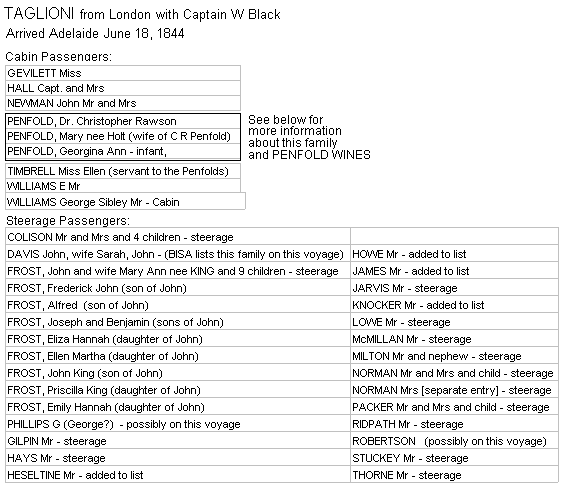TAGLIONI 1844Report published in The South Australian RegisterADELAIDE: WEDNESDAY, June 19, 1844. THE "TAGLIONI," FROM ENGLAND The news by the TAGLIONI, if not altogether as cheering for the Colony as might have been wished, is far from discouraging, our letters and papers affording ample proof of the activity and zeal of our friends at home on behalf of our interests. At the time the TAGLIONI left, three other vessels were laid on for South Australia, the, JOHN HEYES 370 tons, to leave in all March, the YARE 266 tons, to leave in all March, and the UNICORN 375 tons, to leave on the 5th of March, but to come by Swan River and King George's Sound. A number of packages, addressed to the Govenor, and said to consist of ammunition and other kinds of stores, have come out by this vessel, marked "For the Expedition," and said to be intended for a contemplated Exploratory Expedition northward, but of the real facts of which we have as yet no certain information. A considerable quantity of goods was, we understand, shut out of the TAGLIONI for want of room, but they may be expected shortly by the JOHN HEYES, which was to be the next vessel. |
 |
SOUTH AUSTRALIAN REGISTER newspaper Dr CHRISTOPHER RAWSON PENFOLD A grant by purchase of land at Magill, near Adelaide, had been arranged by Dr. Penfold before leaving England and, with the Colony of South Australia barely eight years old, there was scope for a young medical man such as he, with the training of St. Bartholomew's Hospital and some years' experience as a private practitioner as a background. Dr. Penfold practised medicine in the new Colony, making his rounds on horseback and building up around him by his friendliness and integrity a goodwill and esteem that were to outlast his life. |
|
THE ARRIVAL of Dr CHRISTOPHER RAWSON PENFOLD to SOUTH AUSTRALIA It was 1844, towards the end of an Australian winter, when the "Taglioni" cast anchor in the South Australian port of Largs Bay. A tidy little barque of some 350 tons, built only four years earlier at Ramsay in the Isle of Man, she was a well found ship, listed AI at Lloyds, and skippered by her owner, Captain W. Black; but a journey of 13,000 miles on a small sailing vessel in the middle of the nineteenth century was less than comfortable in even the best of weather and in the storms that beset them on this voyage her passengers knew both sickness and peril. Confined for almost three months to the restricted space of deck and cabin, they had time in which to ponder on the comforts of the life they had left behind in England and the uncertainties of a future in an unknown land. But hope travels with adventure, and of the ship-board community the young Dr. Penfold and his wife, at least, during those long evenings while their infant, Georgina, slept, saw success and happiness in the life they planned in the newest of Her Majesty's Australian Colonies. The "South Australian Register" of August 8, 1844, reported the arrival of Dr. Penfold in the Colony, adding, "he is the fortunate purchaser of the delightfully situate and truly valuable estate of Makgill (Magill) at the sum of £1,200." Here, in the hills at the foot of the Mt. Lofty Ranges, the little family set up house, first in a temporary home and, later, in their own white-washed stone cottage which they named "The Grange," and about whose low verandah, pleasant rooms and red cedar woodwork still hangs an air of quiet comfort. Like a few of his contemporaries, he had brought out vine cuttings for planting in his garden. These had been carefully selected from famous wine-growing areas in the South of France and the ends closed with sealing wax to keep the sap in the canes until planting was possible. The vines prospered in the fertile soil at Magill and wines made from their harvest were used by the doctor for cases of anaemia among his patients. The doctor found his time taken up more and more with the making of wines, which were already becoming known for their quality. More vines were planted to meet the growing demand. This meant a large outlay of capital and, in 1870, just when the business was passing through a difficult time, Dr. Penfold died, at the age of 59 years. |
